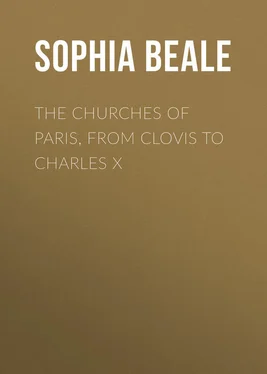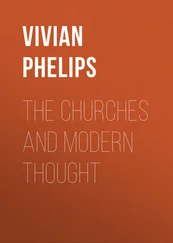Sophia Beale - The Churches of Paris, from Clovis to Charles X
Здесь есть возможность читать онлайн «Sophia Beale - The Churches of Paris, from Clovis to Charles X» — ознакомительный отрывок электронной книги совершенно бесплатно, а после прочтения отрывка купить полную версию. В некоторых случаях можно слушать аудио, скачать через торрент в формате fb2 и присутствует краткое содержание. Жанр: foreign_antique, foreign_prose, на английском языке. Описание произведения, (предисловие) а так же отзывы посетителей доступны на портале библиотеки ЛибКат.
- Название:The Churches of Paris, from Clovis to Charles X
- Автор:
- Жанр:
- Год:неизвестен
- ISBN:нет данных
- Рейтинг книги:3 / 5. Голосов: 1
-
Избранное:Добавить в избранное
- Отзывы:
-
Ваша оценка:
- 60
- 1
- 2
- 3
- 4
- 5
The Churches of Paris, from Clovis to Charles X: краткое содержание, описание и аннотация
Предлагаем к чтению аннотацию, описание, краткое содержание или предисловие (зависит от того, что написал сам автор книги «The Churches of Paris, from Clovis to Charles X»). Если вы не нашли необходимую информацию о книге — напишите в комментариях, мы постараемся отыскать её.
The Churches of Paris, from Clovis to Charles X — читать онлайн ознакомительный отрывок
Ниже представлен текст книги, разбитый по страницам. Система сохранения места последней прочитанной страницы, позволяет с удобством читать онлайн бесплатно книгу «The Churches of Paris, from Clovis to Charles X», без необходимости каждый раз заново искать на чём Вы остановились. Поставьте закладку, и сможете в любой момент перейти на страницу, на которой закончили чтение.
Интервал:
Закладка:
Many of the seventy-three abbots, from Dodon, the first (living in 637), to the last, Jean-François-Paul de Gondi, Cardinal de Retz, were distinguished for their piety, for their learning, their greed, or their vices. Amongst them we find the names of Fulrad, Hilduin, Suger, Mathieu de Vendôme, the Emperor Charles the Bald, the Kings Eudes, Robert and Hugues Capet, 15 15 It seems that one object in electing the king as abbot was to have some lay element in the chapter, and thus disarm the enemies of the Church. Charles le Chauve was abbot for about sixteen years; he chose his provost, treasurer, and dean, and gave into their keeping all the working of the monastery, with the exception of the military contingent, which was given over to the maire or avoué . Adjoining the abbey was a palace for the use of the kings.
the Cardinals de Bourbon, de Lorraine, de Guise, and Mazarin. The conventual buildings were all destroyed in the reign of Louis XV., and during the Revolution the church suffered in the same way as Notre-Dame and S. Eustache, by being secularized in the most revolting manner. But if the Revolutionists destroyed and carried away monuments, the Imperial architects did worse, for they began a restoration in their own hideous taste and "style"; and it was not until a few years ago that the old church was restored to its pristine beauty.
Perhaps few churches have seen more changes than the silent walls of S. Denis have witnessed. The burial place of most of the kings of France, it was also upon its High Altar that Louis le Gros deposited the oriflamme , the famous standard of France, 16 16 The oriflamme , or enseigne derived its name from being made of scarlet silk, and covered with flames of gold. When it was to be taken from its depository, the king and princes first went to Notre-Dame and offered up some prayers to the Blessed Virgin; then they proceeded to the abbey, where, after being solemnly received by the religious, they descended (" sans chaperon et sans ceinture ") into the crypt, where the bodies of the holy martyrs lay, and where the oriflamme was kept. The abbot then delivered the flag into the king's own hands, and the king presented it to the Count de Vesin, who carried it to the altar. The standard-bearer was always a Chevalier of undoubted loyalty, courage, and piety. Previously to receiving the charge, he confessed his sins, obtained absolution, received the Holy Eucharist, and took a solemn oath to be faithful to his trust, and never to suffer the flag to be torn from his hands, except at the cost of his life. But at the battle of Rosbec it mysteriously disappeared. And to think that the red flag is now the emblem of all that is Revolutionary, Communistic, and Anarchist! Perhaps if the Government gave it the old name, we might see it burnt in the Place de la République.
while some seven centuries later, its tombs were only preserved from utter ruin by the wit of Alexandre Lenoir. Even the church itself was threatened with destruction, and was only saved by an architect seriously suggesting that it should be turned into a market, the side chapels forming shops. By turns a Temple of Reason, a dépôt of artillery, a theatre of acrobats, a flour warehouse, and a granary, its desecration was not consummated until the glass was removed, and the leaden covering of its roof converted into bullets. Napoleon saved what remained, and began restoring it as a resting-place for the defunct members of his dynasty. The Concordat guaranteed it a chapter, and religious services were restored. 17 17 The Chapter formerly consisted of a Primicier , Chanoines évêques , non-resident; and Canons residentiary. The office of Primicier was, I think, abolished only a few years ago, and now the chapter simply consists of canons in residence.
But the 19th century proved as disastrous as wars and revolutions. Lightning once more brought down the flèche in 1837, and again in 1846; and scrapings and cleanings carried away all the old surfaces of the walls. Still, through the talent and learning of Viollet-le-Duc, it is one of the finest of 13th century churches, and now that the tombs have all been replaced in their former positions, one of the most interesting.
The façade has three doorways, which are rich in the somewhat rude sculpture of the time of Suger. The subject of the central tympanum and voussure is The Last Judgment. Christ is pronouncing the last sentence, surrounded by the dead who are rising from their graves. His Blessed Mother is interceding for sinners, and Abraham is receiving the elect into his bosom. The Apostles, and the four-and-twenty elders, holding musical instruments, and vases for the reception of the prayers of the just as a sweet-smelling incense, are there, looking on at the damned tossed into hell. Upon the stylobate of the portal we read the parable of the Wise and foolish Virgins.
The southern doorway is decorated with the Martyrdom of S. Denis, and the appearance of our Blessed Lord to the holy martyrs while in prison. Unfortunately, much of these bas-reliefs is modern.
Some statues on one of the transept doorways are curious examples of how a fraud may be perpetuated. They represent, without doubt, some members of the royal house of David, but at some period they were said to be kings of the Capétien line, and as such, casts were taken and sent to Versailles, where they figured as portrait statues of Hugues Capet, Robert, Henri, Philippe, Louis VI., and Louis VII. The capitals of the columns and the foliage ornament of these portals are vastly superior in style to the figures.
On each side of the western rose-window are some bands of black and white marble, after the manner of the churches of Pisa and Genoa, souvenirs , probably, of Suger's travels in Italy. Indeed, he tells us in the account of his administration that he took much trouble in preserving a mosaic which he had brought home and placed in the tympanum of one of the doors. This was unfortunately replaced, in 1774, by a bas-relief of the meanest possible workmanship.
The interior consists of a nave and two aisles, with a chevet of seven chapels at the east end, considerably raised above the level of the nave. Access to these chapels is gained by a flight of steps on each side of the High Altar, and under them is the royal crypt. The whole of the east end of the church, the double aisles, with their single-shaft pillars, the chapels, the vaulting, and the glass, form a mass of colour, and a most beautiful coup d'œil ; 18 18 How fine the effect must have been when the great cross of S. Eloy stood upon the grille , shutting off the nave from the choir! It was of gold, enriched with precious stones and pearls.
indeed, there is but one eyesore in the whole building, the aforesaid series of windows representing Louis Philippe's heroic deeds. Blue swallow-tailed coats and white trousers scarcely form a costume which is either effective or appropriate as designs for church windows.
The wood carving of the stalls is of the 15th century, and was brought from the abbey of S. Lucien-lez-Beauvais; the inlaid marquetry work at the backs of the seats is from the Château de Gaillon, built by Cardinal d'Amboise. Many of the misérérés have the usual quaint conceits which one sees everywhere. Portions of the old glass were preserved by Lenoir in the museum of the Petits-Augustins during the stormy period, and were afterwards replaced in the windows of the apse. They consist mainly of fragments of a tree of Jesse, and may be found in the chapel of the Virgin. There are in all eleven lozenge-shaped medallions representing scenes in the life of Moses, and mystical subjects from the Apocalypse, bearing inscriptions by Suger. Upon the medallion of the Annunciation, the good abbot himself is portrayed prostrate before the Blessed Virgin. In one or two of the other chapels there are a few fragments of the legend of S. Laurence.
Читать дальшеИнтервал:
Закладка:
Похожие книги на «The Churches of Paris, from Clovis to Charles X»
Представляем Вашему вниманию похожие книги на «The Churches of Paris, from Clovis to Charles X» списком для выбора. Мы отобрали схожую по названию и смыслу литературу в надежде предоставить читателям больше вариантов отыскать новые, интересные, ещё непрочитанные произведения.
Обсуждение, отзывы о книге «The Churches of Paris, from Clovis to Charles X» и просто собственные мнения читателей. Оставьте ваши комментарии, напишите, что Вы думаете о произведении, его смысле или главных героях. Укажите что конкретно понравилось, а что нет, и почему Вы так считаете.




![Theresa Cheung - The Dream Dictionary from A to Z [Revised edition] - The Ultimate A–Z to Interpret the Secrets of Your Dreams](/books/692092/theresa-cheung-the-dream-dictionary-from-a-to-z-r-thumb.webp)







